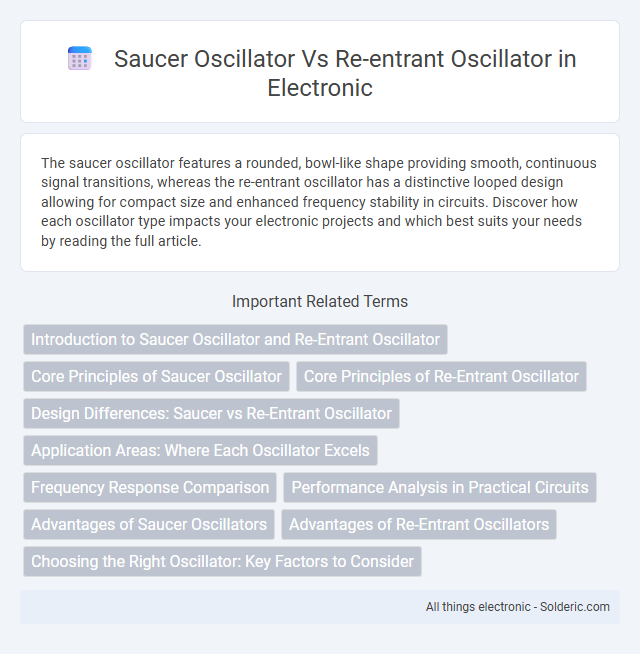The saucer oscillator features a rounded, bowl-like shape providing smooth, continuous signal transitions, whereas the re-entrant oscillator has a distinctive looped design allowing for compact size and enhanced frequency stability in circuits. Discover how each oscillator type impacts your electronic projects and which best suits your needs by reading the full article.
Comparison Table
| Feature | Saucer Oscillator | Re-entrant Oscillator |
|---|---|---|
| Design | Curved, saucer-shaped loop | Loop with re-entrant (loopback) path |
| Frequency Stability | Moderate stability | Higher stability due to feedback path |
| Oscillation Mode | Single-mode oscillation | Multi-mode oscillation possible |
| Applications | Microwave communication, radar | Advanced microwave systems, precision measurements |
| Output Power | Moderate power output | Higher power due to feedback incorporation |
| Size | Compact, simpler geometry | Complex geometry, larger size |
Introduction to Saucer Oscillator and Re-Entrant Oscillator
The Saucer Oscillator features a rounded, bowl-shaped curve used to identify gradual trend reversals and momentum shifts in stock price patterns. The Re-Entrant Oscillator, designed for advanced trading strategies, measures cyclic price movements by re-entering previous oscillation zones to confirm strength or weakness in market trends. Both oscillators provide traders with distinct analytical insights, enhancing decision-making in technical analysis.
Core Principles of Saucer Oscillator
Saucer oscillators operate on the principle of sustained oscillations generated through a continuous feedback loop involving a core shaped like a shallow, disc-like structure, which contrasts with the coil-based design of re-entrant oscillators. The core geometry of the saucer oscillator optimizes magnetic flux distribution, enhancing signal stability and frequency precision. This design minimizes energy losses, enabling efficient oscillation at high frequencies with reduced thermal noise.
Core Principles of Re-Entrant Oscillator
The core principles of a re-entrant oscillator involve using a resonant cavity design that allows electromagnetic waves to travel in a loop, enhancing energy storage and stability through constructive interference. Unlike saucer oscillators, re-entrant oscillators utilize capacitive gaps within the cavity to concentrate electric fields, resulting in higher quality (Q) factors and improved frequency selectivity. Your choice between these oscillators depends on the desired frequency stability and efficiency in precision applications.
Design Differences: Saucer vs Re-Entrant Oscillator
Saucer oscillators feature a planar coil design that promotes uniform magnetic field distribution, enhancing sensitivity and stability in signal generation. Re-entrant oscillators employ a cavity resonator with an axial resonant structure, enabling higher quality factor (Q) and improved frequency selectivity in microwave applications. The key design difference lies in the saucer's flat coil arrangement versus the re-entrant's three-dimensional cavity, influencing their respective performance in resonance stability and frequency control.
Application Areas: Where Each Oscillator Excels
Saucer oscillators are widely used in precision RF signal generation and frequency synthesis, excelling in applications requiring stable and low phase noise outputs such as communication systems and radar equipment. Re-entrant oscillators, with their enhanced Q-factor and compact resonator design, are preferred in high-frequency filtering, sensing, and timekeeping devices where superior frequency stability and miniaturization are critical. Both oscillator types deliver tailored performance for telecommunications, instrumentation, and advanced scientific research, with selection driven by specific operational demands and environmental constraints.
Frequency Response Comparison
The saucer oscillator exhibits a more stable frequency response with minimal phase distortion across a broader frequency range, ideal for precision signal generation. In contrast, the re-entrant oscillator demonstrates a sharper frequency peak but with increased susceptibility to environmental variations, causing frequency drift. Frequency response analysis reveals that saucer oscillators maintain consistent amplitude and phase characteristics, making them preferable for applications requiring high fidelity and low noise.
Performance Analysis in Practical Circuits
Saucer oscillators exhibit superior frequency stability and low phase noise in high-frequency practical circuits compared to re-entrant oscillators, which often face limitations due to their complex feedback path and susceptibility to environmental variations. Practical implementations of saucer oscillators show enhanced amplitude stability and reduced power consumption, making them favorable for integrated circuit applications. However, re-entrant oscillators provide easier tuning and higher harmonic generation capabilities, which are advantageous in specific RF signal generation tasks.
Advantages of Saucer Oscillators
Saucer oscillators offer enhanced stability due to their simplified design and reduced component count, leading to lower phase noise and improved frequency precision. They typically exhibit better thermal management, which minimizes frequency drift under varying temperature conditions. These characteristics make saucer oscillators highly suitable for applications requiring consistent and reliable signal generation.
Advantages of Re-Entrant Oscillators
Re-entrant oscillators offer superior frequency stability and reduced phase noise compared to saucer oscillators, enhancing signal precision in high-frequency applications. Their efficient energy confinement minimizes losses, resulting in improved quality factor (Q-factor) and lower power consumption. The compact design of re-entrant oscillators supports miniaturization, making them ideal for advanced communication systems and precision measurement instruments.
Choosing the Right Oscillator: Key Factors to Consider
Choosing the right oscillator depends on factors such as frequency stability, phase noise, and application requirements. Saucer oscillators offer excellent frequency stability and low phase noise, ideal for precision tasks, while re-entrant oscillators provide compact size and efficient energy transfer, suitable for space-constrained designs. Evaluating your specific needs for performance, size, and power consumption ensures the optimal oscillator choice.
saucer oscillator vs re-entrant oscillator Infographic

 solderic.com
solderic.com